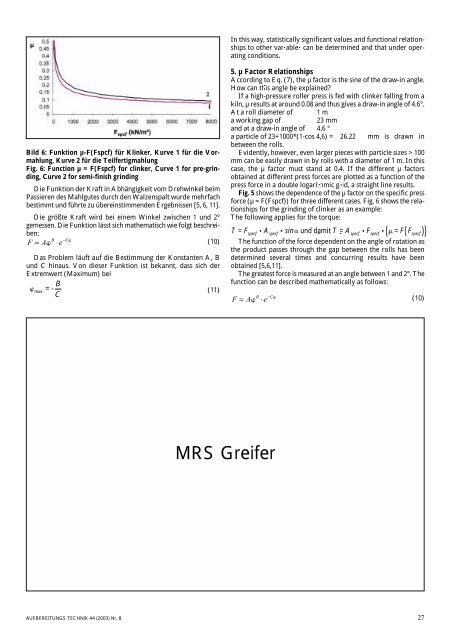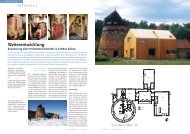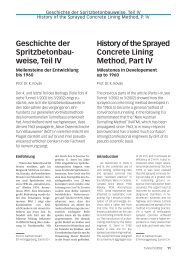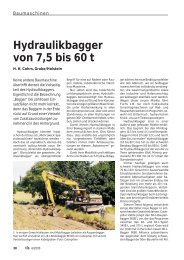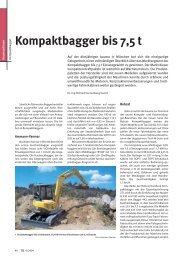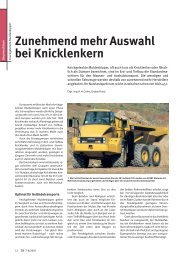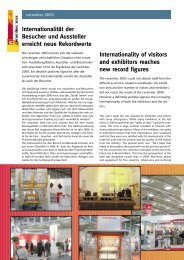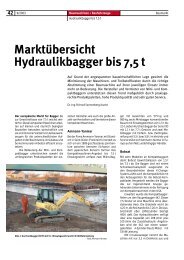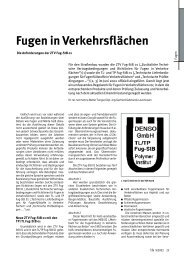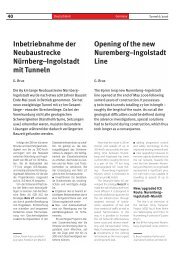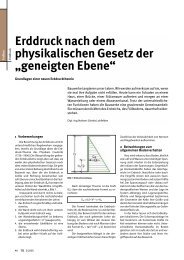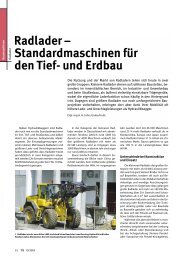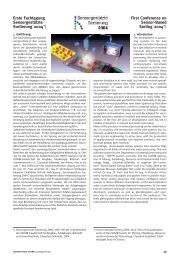Kraftverteilung im Arbeitsspalt von Hochdruck ... - Bauverlag
Kraftverteilung im Arbeitsspalt von Hochdruck ... - Bauverlag
Kraftverteilung im Arbeitsspalt von Hochdruck ... - Bauverlag
Sie wollen auch ein ePaper? Erhöhen Sie die Reichweite Ihrer Titel.
YUMPU macht aus Druck-PDFs automatisch weboptimierte ePaper, die Google liebt.
In this way, statistically significant values and functional relationships<br />
to other variables · · can be determined and that under operating<br />
conditions.<br />
Bild 6: Funktion µ-F(Fspcf) für Klinker, Kurve 1 für die Vormahlung,<br />
Kurve 2 für die Teilfertigmahlung<br />
Fig. 6: Function µ = F(Fspcf) for clinker, Curve 1 for pre-grinding,<br />
Curve 2 for semi-finish grinding<br />
Die Funktion der Kraft in Abhängigkeit vom Drehwinkel be<strong>im</strong><br />
Passieren des Mahlgutes durch den Walzenspalt wurde mehrfach<br />
best<strong>im</strong>mt und führte zu übereinst<strong>im</strong>menden Ergebnissen [5, 6, 11].<br />
Die größte Kraft wird bei einem Winkel zwischen 1 und 2°<br />
gemessen. Die Funktion lässt sich mathematisch wie folgt beschreiben:<br />
F A B −C<br />
= ⋅e<br />
(10)<br />
Das Problem läuft auf die Best<strong>im</strong>mung der Konstanten A, B<br />
und C hinaus. Von dieser Funktion ist bekannt, dass sich der<br />
Extremwert (Max<strong>im</strong>um) bei<br />
max<br />
=- B C<br />
(11)<br />
5. µ Factor Relationships<br />
According to Eq. (7), the µ factor is the sine of the draw-in angle.<br />
How can this · angle be explained?<br />
If a high-pressure roller press is fed with clinker falling from a<br />
kiln, µ results at around 0.08 and thus gives a draw-in angle of 4.6°.<br />
At a roll diameter of 1 m<br />
a working gap of<br />
23 mm<br />
and at a draw-in angle of 4.6 °<br />
a particle of 23+1000*(1-cos 4,6) = 26.22 mm is drawn in<br />
between the rolls.<br />
Evidently, however, even larger pieces with particle sizes > 100<br />
mm can be easily drawn in by rolls with a diameter of 1 m. In this<br />
case, the µ factor must stand at 0.4. If the different µ factors<br />
obtained at different press forces are plotted as a function of the<br />
press force in a double logarithmic · grid, · a straight line results.<br />
Fig. 5 shows the dependence of the µ factor on the specific press<br />
force (µ = F(Fspcf)) for three different cases. Fig. 6 shows the relationships<br />
for the grinding of clinker as an example:<br />
The following applies for the torque:<br />
T F A und damit · T · A F F F<br />
=<br />
specf specf<br />
=<br />
specf specf<br />
= ( specf )<br />
The function of the force dependent on the angle of rotation as<br />
the product passes through the gap between the rolls has been<br />
determined several t<strong>im</strong>es and concurring results have been<br />
obtained [5,6,11].<br />
The greatest force is measured at an angle between 1 and 2°. The<br />
function can be described mathematically as follows:<br />
F = A<br />
B ⋅e<br />
* * sin * * ( )<br />
−C<br />
(10)<br />
MRS Greifer<br />
AUFBEREITUNGS TECHNIK 44 (2003) Nr. 8 27


